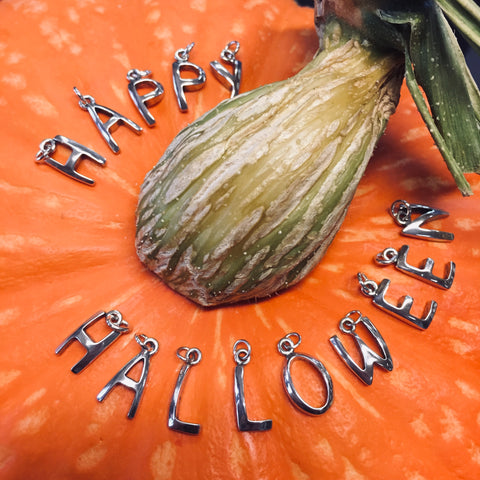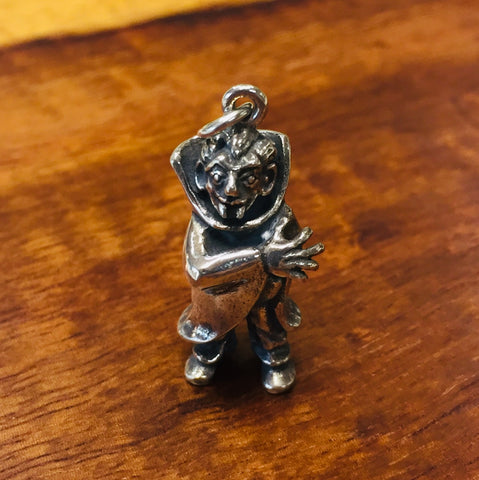Spooky Halloween Myths With Factual Origins!
Introduction:
Since Halloween is no more than 12 days away, I thought it would be interesting to discuss the origins of this extremely entertaining holiday, as well as discuss one of the more gruesome Halloween myths! Believe me when I tell you, Halloween's beginnings might surprise you and the myth we've chosen is downright horrifying and well worth reading about if you want to be in a spooky Halloween mood!
Halloween's Pagan Origins:
Halloween's pagan origins are unmistakable and can be traced to the British Isles and the holidays marking the change in season from the light and warmth of summer to the cold and darkness of winter. To the Irish, it was known as Samhain (summer's end). To the Welsh, Nos Galen Gaeaf (winter's eve) and to the Anglo-Saxons Blodmonath (blood month). [Hutton P1] Ronald Hutton, a well-respected medieval historian, astutely points out that these holidays were both a nod to the hard times ahead, as well as a celebration of the plenty that they enjoyed at the end of summer. Larders would have been overflowing with the food brought in from the summer harvest and a great deal of livestock would be slaughtered and salted so that they would not have to be fed over the winter. In this sense, the festivities around all hallows eve could be seen as a time of excess. They also acknowledge the coming times when everyone must tighten their belts and survive the long dark of winter. Even as I write this, I can feel the onset of winter in the cold breeze and the way that the sun flees rapidly from the sky. For us modern folk, it just means that there will be Christmas decorations at Target soon, but for medieval peoples this was a time of extreme uncertainty. More people would die in wintertime than in any other time of the year according to Hutton, and this easily led to the belief that demons and malevolent spirits roamed the darkness beyond the feeble yellow light of your lantern.
For reasons unknown, Pope Gregory III moved All Saints Day from May 13th to November 1st, effectively intertwining the pagan agricultural rituals with those of Christianity. The newly combined holiday (holy day) enjoyed great popularity in medieval times and was only extinguished as Protestantism swept aside papist and pagan ritual. Surviving predominantly in Ireland, Halloween was brought to the United States in the 1840s, when catastrophic famines forced the emigration of millions of Irish people. Here it enjoyed resurgent popularity and new traditions, such as the Jack O' Lantern, blossomed out of the old.
The Haunting Irish Tale That Gave Us The Jack O' Lantern:
The custom of carving pumpkins into grotesquely faced lanterns is an American practice with roots in old world traditions. In Ireland, turnips, rutabagas and potatoes were hollowed out, carved with faces and illuminated with embers to ward off evil spirits on All Hallows Eve. [Merriam Webster p2] It remains slightly unclear, how the term Jack-O'-Lantern was applied, but the most credible theory is that the name originates from the 17th century Irish legend of 'Stingy Jack'. This is the tale of a man, who more than once, managed to con the Devil himself and paid a mighty and terrible price for it.
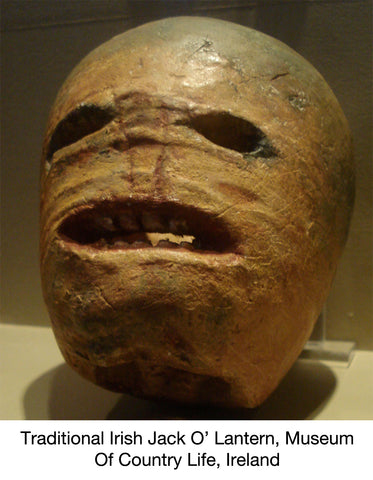
It is said that Jack was known throughout the land for his tight purse strings, silver tongue, and love of booze. These attributes drew the devil to him like a moth to a flame. Upon meeting, Jack realized that the Devil had come to collect his soul, and convinced the Devil to let him have one last drink. Jack consumed his fill of ale for which he convinced the devil to pay by transforming himself into a silver coin to be paid to the barkeep. Before the Devil realized what had happened, Stingy Jack had snatched up the coin and thrust it into his pocket next to a crucifix. The crucifix prevented the Devil from changing back into his normal form and being hopelessly trapped, he had no choice but to submit to Jack's demands. Jack demanded that the Devil leave him alone for a full year and that if he should die, the Devil could not collect his soul. After a year had elapsed, they crossed paths for a second time. Yet again the Devil fell victim to Jack's clever ways. While the Devil retrieved a piece of fruit from a tree, Jack carved a cross into the trunk trapping the Devil in the branches. Again he was forced to meet Jack's demands which were that the Devil could not bother Jack for an additional ten years. Upon Jack's death, he was refused entry into heaven for his life of debauchery and sin. He was even turned away from Hell with the Devil's parting gift of an ember from the fires of Hell with which to light his way as his only consolation. Jack tucked this ember into a hollowed out turnip lantern to light his way and now wanders the darkness of night for eternity. [History Channel]
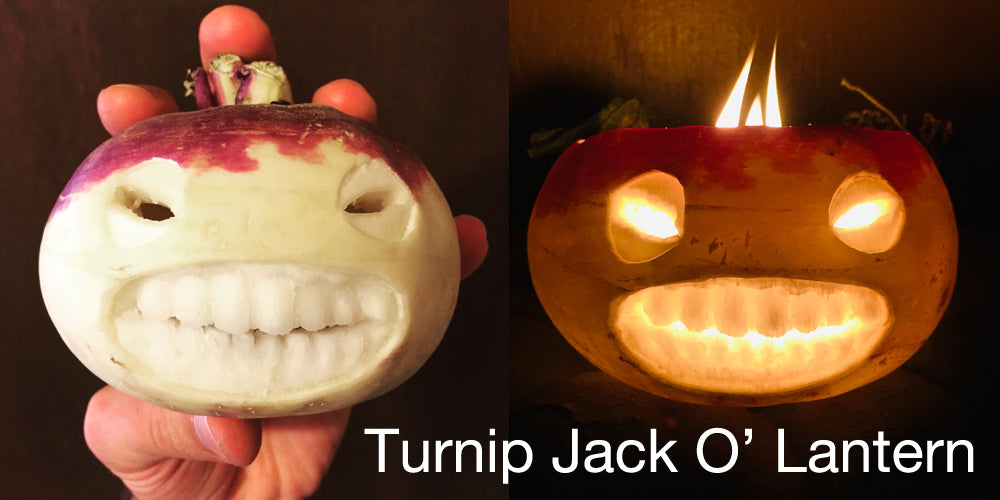
The tradition of carving root vegetables, lighting them and placing them in doorways and windows to ward off spirits like Stingy Jack became an annual tradition on All Hallows Eve. The 19th century immigration of many Irish people to the United States brought these traditions to our shores, except that they found the Pumpkin a far better Jack O' Lantern subject! [History] We use silver, gold vermeil and 14 karat gold for our Jack O' Lantern Charms and Pendants.
The Absolutely Horrifying Truth Behind the Dracula Story:
Myths of blood sucking creatures are in no way a new idea or even unique to a single country. Though they may not have used the term vampire, China, Greece, India and England all had their own versions of the blood sucking monster that stalked the night. Most vampire folklore in these areas revolved around a fear of the dead and roaming spirits, coupled with rampant disease in the ancient and medieval world. Before the age of modern medicine and basic understanding of microorganisms, it is easy to attribute things like the plague, cholera and tuberculosis to the malevolence of evil spirits or the waking dead. This sometimes resulted in towns disinterring newly buried corpses in order to seek out the culprit and put an end to their deadly capers (ironically this could spread disease even further within the community). [Cochrane]
What the modern mind thinks of, when it conjures an image of a Vampire is often something like the film and stage adaptations of Bram Stoker's 1897 novel, Dracula. Even the cloak originates from the theatrical versions of this story. Used to hide the actor as he plummeted through a trap door in the stage, creating the illusion that he had disappeared! [Cochrane]
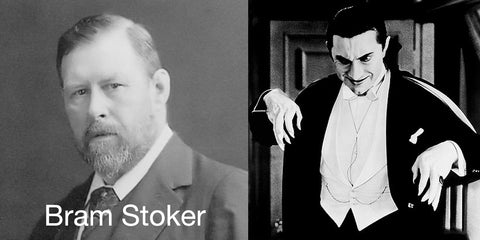
The origins of the name 'Dracula' stem from someone whose exploits are far more sinister and sadistic than any acts the fictional vampires carried out. In fact, the name is about the only tie between Dracula and his nominal inspiration Vlad III (better known as Vlad the Impaler). Vlad III, Prince of Wallachia, played an active role in the Ottoman-Hungarian Wars, a bitter and desperate 15th century struggle to keep Turkish rule out of the Kingdom of Hungary. His father Vlad II had been inducted into the knightly Order of the Dragon, an organization with the pledged goal of ridding the region of the Turks once and for all. This new knighthood earned him the surname 'Dracul'. Vlad III "would later be known as 'son of Dracul' or, in Old Romanian, Drăculea...".[Lallanilla P9]
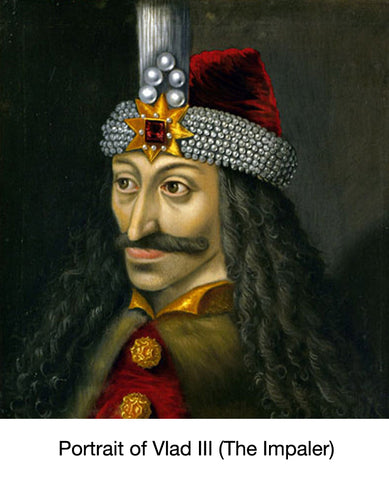
The exploits of Vlad III have come to us via woodcuts and pamphlets produced at the time as well as shortly after and what they portray should raise the hair on the back of your neck. In order to gain control of the region he oversaw, he invited the local nobility to a banquet at which he ordered them stabbed and then while still clinging to life, impaled as seen in this 15th century woodcut.

A second instance occurred in 1462, when the invading Turkish army was able to march all the way to the region capital. What they found there would chill anyone to the bone. Using captured prisoners, Vlad III had carpeted the valley below the capital city with 20,000 impaled Turks. Despite these gruesome military exploits, Vlad was overcome and killed. His head was severed from his body and preserved in a jar of honey which was sent to the Ottoman capital as proof that the dreaded Vlad would trouble the Turks no longer. [Nuwer]
Our sterling silver Dracula has more of a Sesame Street feel than a Vlad the Impaler feel as Pat will invariably carve cute before gruesome! I hope you've enjoyed a brief history lesson as well as the pictures of our sterling silver interpretations of these Halloween myths! If you're enjoying the blog, please add your name to our newsletter for updates on article releases as well as the occasional money saving coupon! Happy Halloween Everyone!
References:
Cochrane, Ford, "Where Do Vampires Come From?", National Geographic Blog, https://blog.nationalgeographic.org/2010/02/22/where-do-vampires-come-from/, Accessed 10/16/2018
History Channel Editors, 'History of the Jack O' Lantern', The History Channel, https://www.history.com/topics/halloween/jack-olantern-history, Accessed 10/15/2018
Hutton, Ronald, "Halloween? It's more than trick or treat", The Guardian, https://www.theguardian.com/commentisfree/2014/oct/28/halloween-more-than-trick-or-treat-origins, Accessed 10/9/2018
Lallanilla, Marc, "The Real Dracula: Vlad the Impaler", Live Science, https://www.livescience.com/40843-real-dracula-vlad-the-impaler.html, Accessed 10/16/2018
Moss, Candida, "Halloween: Witches, old rites and modern fun", BBC, http://www.bbc.co.uk/religion/0/24623370, Accessed 10/9/2018
Merriam Webster, 'The History Of Jack-O'-Lantern', Merriam Webster, https://www.merriam-webster.com/words-at-play/the-history-of-jack-o-lantern, Accessed 10/9/2018
Nuwer, Rachel, 'Archeologist Think They've Found The Dungeon Where Dracula Was Kept', The Smithsonian, https://www.smithsonianmag.com/smart-news/archaeologists-think-theyve-found-dungeon-where-dracula-was-kept-180952913/, Accessed 10/16/2018
1 comment
oh, humans! truly frightening!

